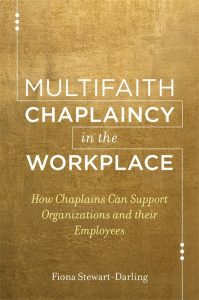Fiona Stewart-Darling, Multifaith Chaplaincy in the Workplace: How Chaplains Can Support Organizations and their Employees (London: Jessica Kingsley, 2017);
As we continue to debate the effects of secularism on the life of faith with, at least, statistical evidence to suggest steady decline, this book begins with the premise that faith and religion are still very much present and important both in the lives of individuals and in the public arena. The story of the Canary Wharf multi-faith chaplaincy is narrated with skill and in the conviction that, through this ministry, faith can positively influence the well-being of employees in global companies.
Present in all seven chapters is a quality of analysis and consequent understanding of the context of the workplace within which chaplaincy seeks to be a faithful presence. The background to this context is the life-changing consequences of the global financial crisis, which offered important opportunities for this chaplaincy team. The strength of chaplaincy provision often depends on the character of the individual chaplain and their capacity to form and develop strong relationships. This liminal work, often with few immediate or obvious results, is often best enabled within the context of a team. Multi-faith teamwork is examined in Chapter 3, with some insightful contributions from Muslim and Jewish chaplains. Chapter 4 explores the nature of wisdom alongside ethics, values and culture as it seeks to understand how people can make the best decision possible, especially given the nuances and contradictions of many business decisions. We are asked to think about the nature of anxiety about religion in the workplace in Chapter 5.
A positive and mature vision of religious practice as one nurturing respect and value is offered, although how tolerant of diversity and difference some religious ideologies can allow themselves to become deserves further consideration. The relationship between chaplaincy and faith communities is opened up in Chapter 6. There is an intriguing and attractive discussion of the role of chaplain as translator of the world to the faith community along with an expressed commitment to practise theology in the workplace.
The book would have been strengthened with a more comprehensive bibliography, especially in the area of chaplaincy studies. It would also be interesting to know whether there are any plans to engage in further independent research about the nature of the impact of this innovative ministry. Visibility, approachability and personality seem to be key qualities in the relative success of such a work-based ministry. Freedom from both buildings and ecclesiastical structures should certainly not be underestimated as a means of enabling human connectivity and Christian witness. Stewart-Darling offers a radically distinctive model of Church and poses challenges to inherited models of ministry, which deserve further consideration. There remains a set of unanswered questions about the Christian nurture of laypeople and their empowerment to engage theologically with the world. Released to do this, we might live within a very different and creative spiritual confidence about the living and practice of faith. Perhaps a new revolution of ministry from community (of parish) to workplace beckons?
James Woodward
Sarum College
